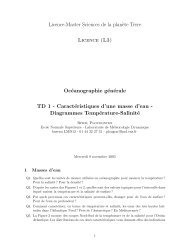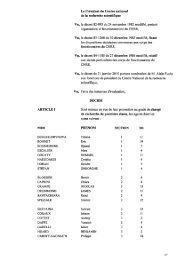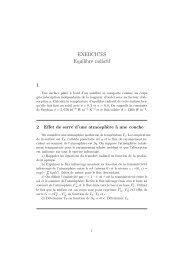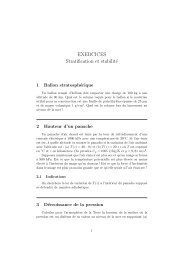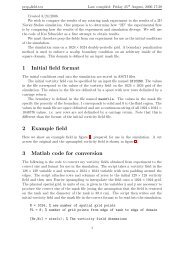1 2D Continuous wavelet transform
1 2D Continuous wavelet transform
1 2D Continuous wavelet transform
Create successful ePaper yourself
Turn your PDF publications into a flip-book with our unique Google optimized e-Paper software.
<strong>2D</strong>cwttools.tex Last compiled: Monday 22 nd January, 2007 15:33As one can see, this is not zero at k = 0. Strictly speaking, this formula does notsatisfy the admissibility condition for a <strong>wavelet</strong> (roughly speaking it does not have a zeromean). We can either enforce the admissibility by setting ˆψ(k = 0) = 0 1 or by makinga correction to the formula to satisfy the admissibility condition. We use the analyticcorrection so that the resulting zero mean formula for the complex Morlet <strong>wavelet</strong> becomesψ(x, y) = (e ik ψx − e − 1 2 k2 ψ )e− 1 2 (x2 +y 2 )(10)The correction factor e − 1 2 k2 ψ is small, but not always negligible (depending on the valueof k ψ ). I prefer to use the correction, as it is not ad hoc and does not complicate thingstoo much. The Fourier <strong>transform</strong> of the corrected complex Morlet <strong>wavelet</strong> isso thatˆψ(k) = √ 2π[e − 1 2 (2πk−k ψ) 2 − e − 1 2 k ψ 2 e − 1 2 (2πk)2 ] (11)ψ(k x , k y ) = √ 2π[e − 1 2 (2πkx−k ψ) 2 +(2πk y) 2 − e − 1 2 k2 ψ e− 1 2 (2πk2 x+2πk 2 y] (12)Note that in Fourier space the correction rapidly decreases away from the |k| = 0origin. For the <strong>wavelet</strong> at a given dilation a, its frequency centered at k = k ψ /2πa where∫ ∞k| ˆψ(k)|dk0k ψ = ∫ ∞| ˆψ(k)|dk(13)0Is the barycenter of the <strong>wavelet</strong> in Fourier space.It is important to find the correspondence between the dilation parameter a and thescale of the <strong>wavelet</strong>. We first find the relation between the central frequency of the <strong>wavelet</strong>and the dilation parameter a.The calculus involved in calculating k ψ for the complex Morlet <strong>wavelet</strong> is a bit messy,but the result is clean and should be obvious. For the complex Morlet <strong>wavelet</strong>k ψ = k ψ (14)A result we should recognize as obvious, since this is what we put into the <strong>wavelet</strong>.We empirically set the length scale of the complex Morlet l = 1 at value of dilationparameter a = 0.1329. Therefore to convert between the scale of the Morlet l, basedupon the domain size, and the dilation parameter, a = 0.1329l. Therefore to convert towavenumberk ψk =(15)(2π(0.1329)l).We also include rotations. Rotations can be included in the extension to higherdimensions. This can give the <strong>wavelet</strong> a sensitivity to direction.ψ l,x ′ ,θ(x) = l n/2 ψ[Ω −1 (θ) x − x′] (16)l1 Note that in Matlab the DC mode is stored at the first index of the matrix resulting from the fft2function. I.e. if Y = fft2(X); then Y(1,1) = sum(sum(X)); is the DC mode.2







